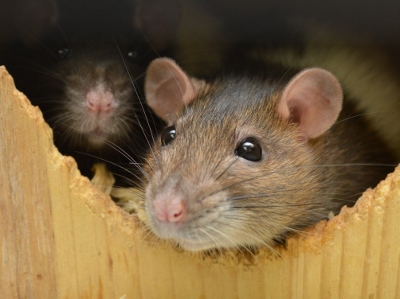
It’s a rat race out there and our Animal of the Month for June, the rat, is running a little late. Perhaps he was having too much fun over the Canada Day weekend? Regardless, now it’s time to say good-bye to the rat as our Animal of the Month. We hope you enjoyed our tweets @ExoticPetVets about these very intelligent and often misunderstood little creatures. In case you missed any of our tweets, here is a summary. Did you know?:
- Did you know that there are more than 50 species of rats? They belong to a superfamily of rodents called Muroidea in scientific classifaction.
- Nearly all rats in captivity are descended from the brown rat species (Rattus norvegicus), which is also known as the Norway rat.
- Selective breeding has created a wide variety of domesticated rats within the brown rat species. They can be differentiated from each other through characteristics such as coat or body variations, markings and eye colour.
- In addition to being bigger than mice, rats also have much longer tails compared to mice
- Their long hairless tails can’t grip anything, but they do help rats keep their balance when they’re walking along narrow surfaces like fences or ropes.
- Rat tails also contain blood vessels which can control the volume of blood that flows to the tail. This function helps rats regulate their body temperature as the heat from the blood is radiated out through the tail.
- A doe may be a female deer, but did you know that a female rat who has not mated is also called a doe? A pregnant or mother rat is called a dam, while a male rat is called a buck.
- Baby rats can be referred to as either kittens or pups. A group of rats is called a mischief.
- Rats can breed prolifically and they reach sexual maturity at just five-weeks of age.
- Female rats can breed year-round and they can also become pregnant again right after giving birth. They usually have litters of around seven kittens/pups, but litters can be as large as 14.
- Spaying and neutering rats in captivity not only helps control the rat population, but also significantly reduces the risk of some cancers in rats.
- Our Dr. Rick Axelson has written about the benefits of spaying and neutering rats. You can find his articles in the Illustrated Articles section of our website.
- Did you know that rats make a laughing-type sound when they’re having fun?
- Check out this video of rats laughing while being tickled in science experiments: https://www.youtube.com/watch?v=d-84UJpYFRM
- Rats make wonderful family pets. They are social animals who enjoy the company of other rats. Domesticated rats also enjoy spending time with their human family.
- Despite what many people think of them, rats are also very clean animals and will spend many hours each day grooming themselves.
- Rats are also extremely intelligent and they have good memories. In captivity, rats can learn to respond to their names and can learn to do many tricks.
- Humans have a love-hate relationship with rats. On the one hand, some people view rats as dirty, disease-ridden vermin.
- In the English language, being called a “rat” is also used as an insult and saying “rats!” is used to convey feelings about a negative situation.
- In the Chinese horoscope, people born in the Year of the Rat are characterized as being intelligent, honest, sensitive and generous.
- In Hinduism, the god Ganesha is often depicted as being attended by or riding on a rat. And the Karni Mata Temple in northern India is also known as The Temple of Rats.
- Rats have been exonerated from the long-held belief that they spread the bubonic plague, or Black Death, in 14th century Europe.
- In recent years, focus turned from rats to gerbils as the main culprits who spread the bubonic plague. But earlier this year, a study suggested that it was actually humans who spread the Black Death. https://www.bbc.com/news/science-environment-42690577
Rats have been featured as our Animal of the Month once before. Check out our blog post from June 2015 to see what we tweeted about rats the first time they were in our featured creature!

